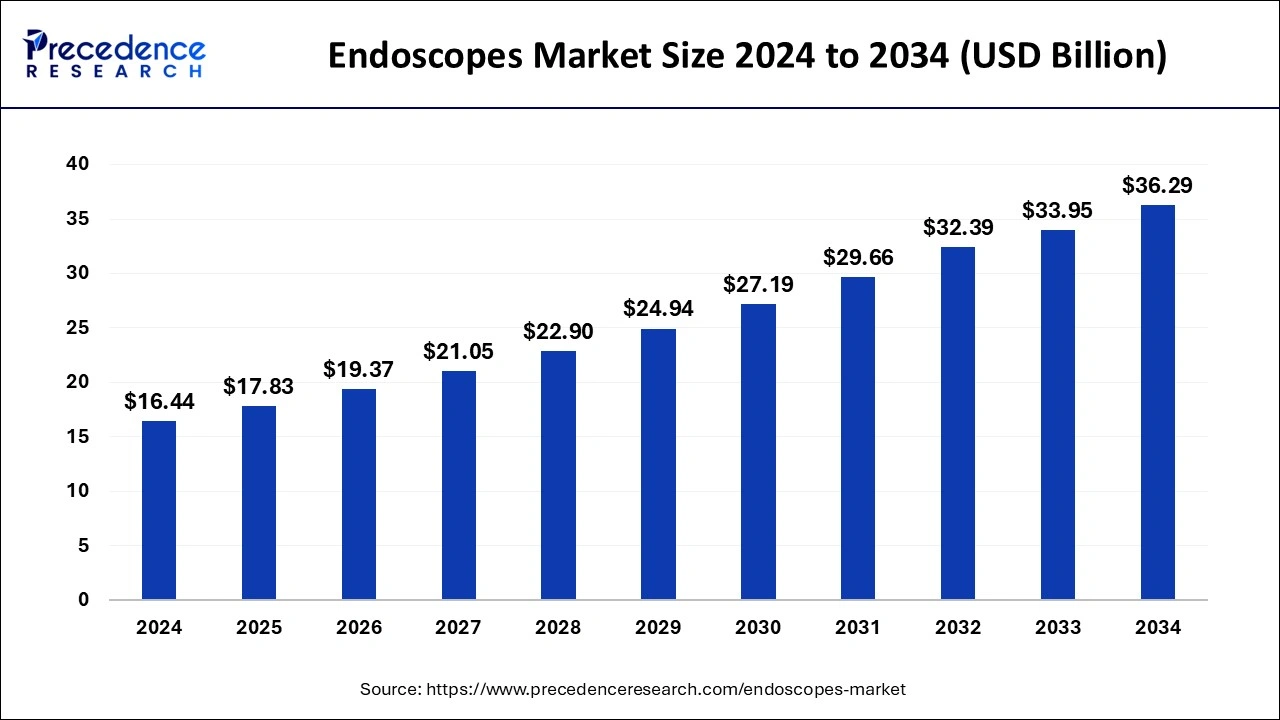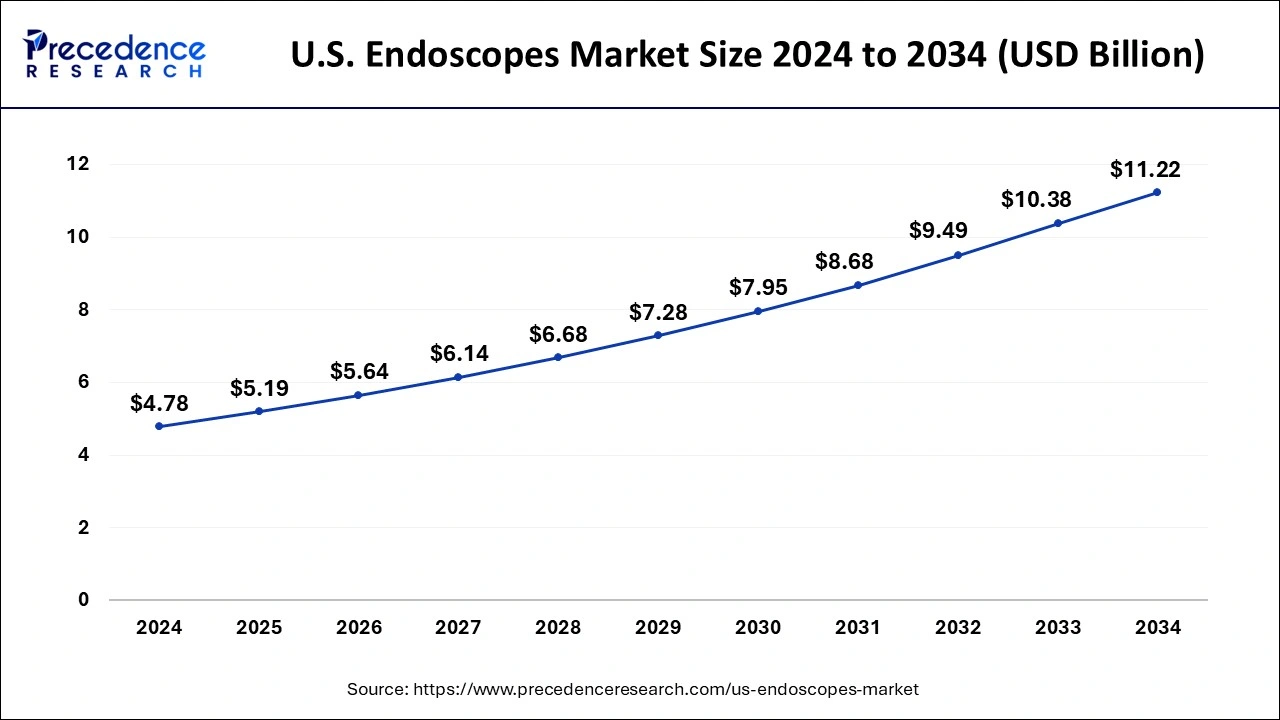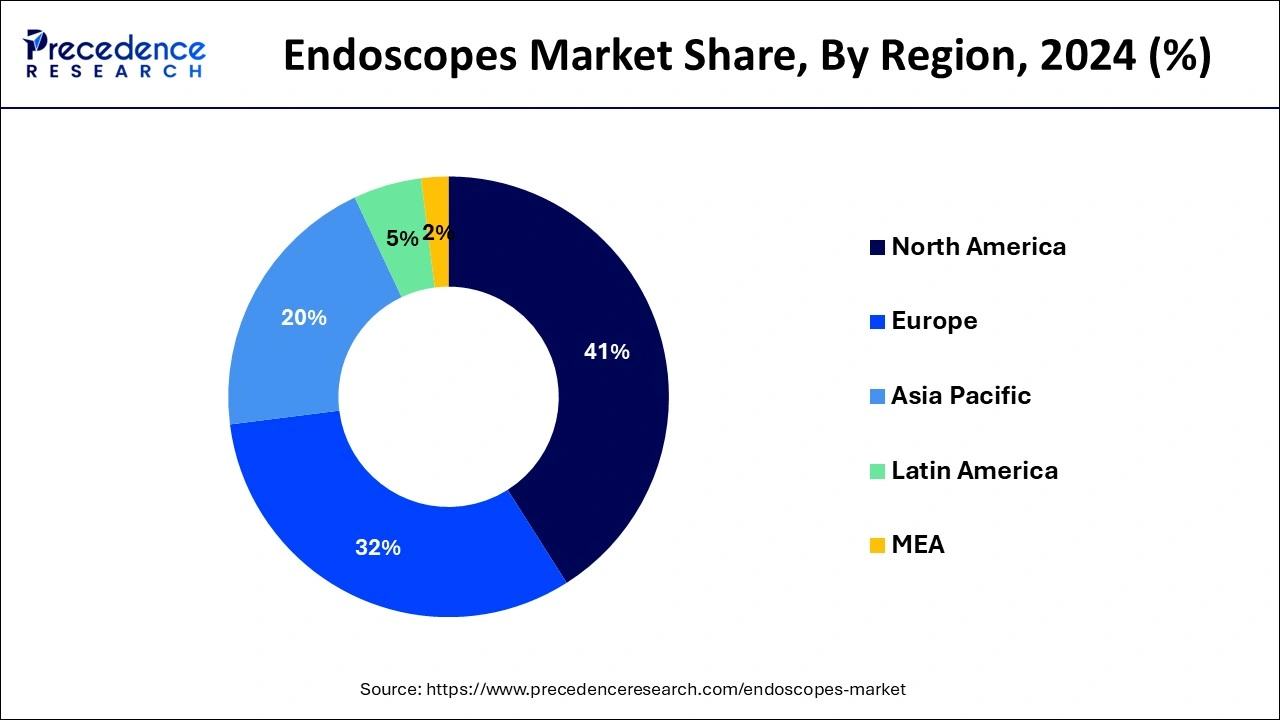April 2025
The global endoscopes market size is calculated at USD 17.83 billion in 2025 and is forecasted to reach around USD 36.29 billion by 2034, accelerating at a CAGR of 8.39% from 2025 to 2034. The North America endoscopes market size surpassed USD 6.74 billion in 2024 and is expanding at a CAGR of 8.41% during the forecast period. The market sizing and forecasts are revenue-based (USD Million/Billion), with 2024 as the base year.
The global endoscopes market size was estimated at USD 16.44 billion in 2024 and is anticipated to reach around USD 36.29 billion by 2034, expanding at a CAGR of 8.39% from 2025 to 2034. The growth of the endoscopes market is driven by the rising demand for minimally invasive surgery. Endoscopes allow physicians to observe the inside of the body without performing major surgery.

Artificial intelligence (AI) has a profound impact on the overall healthcare sector. AI technologies have proven instrumental in revolutionizing healthcare delivery. With AI technologies, thorough evaluation and enhanced imaging and diagnostic are possible, which enhances the accuracy of endoscopy procedures. AI-driven endoscopes allow early detection, improve accuracy and precision, and transparency that helps medical professionals make informed decisions. Moreover, AI streamlines workflows in endoscopic procedures, reducing the burden on healthcare professionals and increasing efficiency.
The U.S. endoscopes market size was evaluated at USD 4.78 billion in 2024 and is predicted to be worth around USD 11.22 billion by 2034, rising at a CAGR of 9% from 2025 to 2034.

North America gathered major revenue chunk in 2024 of over 41% with of the total endoscopy devices market is projected to uphold this drift throughout the assessment period. This progress credited is upsurge infrequency of chronic diseases plus augmenting elderly population, great acceptance rate of technically cutting-edge endoscopy devices, and great responsiveness concerning the paybacks of endoscopy interventions. Additionally, intensification in measures for preventive healthcare, occurrence of highly sophisticated healthcare organization, and encouraging reimbursement setting is further pushing the market growth in this region.

India, Brazil, Russia, China, and South Africa are amongst the fastest-growing nations across the world. The World Economic Forum evaluates these emergent markets will occupy about one-third of the global healthcare spending in 2020. Now, numerous endoscopy equipment makers are setting up their plants in the Middle East, Asia Pacific, and Latin America. Leading companies like KARL STORZ and Stryker have already set up their R&D and manufacturing facilities in these nations. Furthermore, market maturity in established regions like North America and Europe, will further push endoscopy equipment manufacturers to emphasis on evolving nations during years to come.
Endoscopy and related devices have gained immense traction in the past few years. Endoscopes are widely used for diagnostic and therapeutic procedures. At present, HD format and HD+ technologies are making endoscopes highly reliable and effective. Further, better-quality designs have made flexible GI endoscopes easy to use, and smaller instrumentation has permitted more dedicated devices. Since the previous decade, the demand for flexible endoscopes has increased, mostly due to patients’ inclination towards minimally invasive procedures.
Commonly, endoscopic processes are low-risk actions and are covered under health insurance policies. An upsurge in the number of aged populations with high risk of orthopedic, gastrointestinal, and ophthalmic diseases and cancer is driving the growth of the endoscopes market across the world. As per statistics by the World Health Organization (WHO), between 2000 and 2050, the proportion of the world's population aged 60 years and above will be twice from around 11% to 22%. This elderly population is the leading end user of bariatric surgeries, colonoscopy procedures, knee-hip implants, and gastrointestinal endoscopy, among others.
| Report Highlights | Details |
| Market Size in 2024 | USD 16.44 Billion |
| Market Size in 2025 | USD 17.83 Billion |
| Market Size by 2034 | USD 36.29 Billion |
| Growth Rate from 2025 to 2034 | CAGR of 8.39% |
| Largest Market | North America |
| Base Year | 2024 |
| Forecast Period | 2025 to 2034 |
| Segments Covered | Product, Application, End User, Region |
Increasing Prevalence of Gastrointestinal Diseases
The increasing number of cases of gastrointestinal diseases, such as constipation, dyspepsia, and inflammatory bowel disorder (IBD), leads to a high demand for endoscopic procedures. The need for effective diagnostic solutions increases as these conditions become more common. However, endoscopes are essential to manage these conditions because they can analyze the GI tract in detail.
Expanding Healthcare Facilities
The rapid expansion of healthcare facilities, especially in emerging countries, drives the growth of the endoscopes market. Governments of various nations are also investing in improving healthcare facilities in underserved areas. This, in turn, boosts the demand for medical devices, including endoscopes. Furthermore, with the rising consumer disposable incomes in emerging countries, healthcare expenditure is increasing, contributing to market expansion.
High Costs
The costs associated with endoscopy procedures are high and require a certain healthcare infrastructure in place. This cost includes procurement and maintenance of endoscopes and related equipment, as well as staff training. This makes endoscopic procedures costlier. In emerging countries, the healthcare infrastructure is still developing, which adds further pressure. Purchasing advanced endoscopic equipment is challenging for small healthcare organizations due to budget constraints, limiting the market's growth.
Technological Advancements
Rising advancements in endoscopic technology create immense opportunities in the market. Innovations like HD imaging and 3D visualization enhance the efficacy and accuracy of endoscopy procedures. Over the past years, technological advancements have made endoscopes more operative in performing procedures. Advancements in technology have paved the way for the development of robotic-assisted endoscopy. Such developments enhance precision and improve patient outcomes.
Different types of product segments assessed in this report include flexible endoscopes, capsule endoscopes, robot assisted endoscopes, rigid endoscopes, disposable endoscopes and others.
Among all, flexible endoscopes gathered highest market revenue 47% in 2024 due to growing inclination on account of improved safety, ergonomics, and effectiveness over rigid endoscopes.
Among different applications evaluated in this report, GI endoscopy accounted for major market revenue of around 51% in 2024. Intensifying burden of GI diseases, plus mounting geriatric populace is motivating GI endoscopy demand worldwide. GI tumors are the second prevalent reason of cancer-associated deaths across the globe. Thus, less risk of surgical site infection (SSI), technical developments and low cost offered by surgeries than others are some of the considerable factors driving the progress of this segment in the global endoscopes market.
Different end-users of endoscope products include ambulatory surgical centers or clinics, hospitals, and other. Other segment involves mobile endoscopy facilities, diagnostic centers, and office endoscopy services.
Among these, hospitals appeared as the prevalent end-user in 2024 and garnered a market share of 48.1%, due to extensive implementation of endoscopes and an upturn in the amount of surgeries accomplished in hospitals. Further, cumulative private and government subsidy and upward trend among patients and physicians to execute endoscopic processes in a hospital-based environment are driving the growth.
This research study comprises comprehensive assessment of the marketplace revenue with the help of prevalent quantitative and qualitative acumens, and forecasts of the market. This report presents breakdown of market into major and niche segments. Furthermore, this research study gauges market revenue growth and its drift at global, regional, and country from 2025 to 2034. This report includes market division and its revenue assessment by categorizing it depending on product, application, end-user and region as follows:
By Product
By Application
By End-Use
By Regional Outlook
For inquiries regarding discounts, bulk purchases, or customization requests, please contact us at sales@precedenceresearch.com
No cookie-cutter, only authentic analysis – take the 1st step to become a Precedence Research client
April 2025
February 2025
April 2024
February 2025